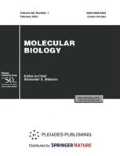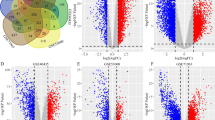Abstract
Clear cell renal cell carcinoma (ccRCC) is a common oncourological disease with a high mortality level. The incidence of this type of cancer is constantly increasing, while molecular mechanisms involved in the disease initiation and progression remain far from being fully understood. A problem of the search for novel markers is crucial for improvement of diagnosis and therapy of ccRCC. We have previously found that the disease is characterized by increased expression of the NETO2 gene. In the present study, we showed that isoform 1 (NM_018092.4) makes the main contribution to the upregulation of this gene. Using original CrossHub software, “The Cancer Genome Atlas” (TCGA) project data were analyzed to identify possible mechanisms of NETO2 gene activation in ccRCC. The absence of significant contribution of methylation to the increase of mRNA level of the gene was observed. At the same time, a number of genes encoding transcription factors, which could potentially regulate the expression of NETO2 in ccRCC, were identified. Three such genes (MYCBP, JMY, and SAP30) were selected for the further analysis of their mRNA levels in a set of ccRCC samples with quantitative PCR. We showed a significant increase in mRNA level of one of the examined genes, SAP30, and revealed its positive correlation with NETO2 gene expression. Thus, upregulation of NETO2 gene is first stipulated by the isoform 1 (NM_018092.4), and the probable mechanism of its activation is associated with the increased expression of SAP30 transcription factor.
Similar content being viewed by others
Abbreviations
- qPCR:
-
quantitative PCR
- ccRCC:
-
clear cell renal cell carcinoma
- CUB:
-
complement C1r/C1s, Uegf, Bmp1
- KAR:
-
kainate receptor
- LDLa:
-
low-density lipoprotein, class A
- NMDA:
-
ionotrope glutamate receptor
- RNA-seq:
-
RNA sequencing
References
Siegel R.L., Miller K.D., Jemal A. 2015. Cancer statistics, 2015. CA Cancer J. Clin. 65, 5–29.
Lopez-Beltran A., Carrasco J.C., Cheng L., et al. 2009. 2009 update on the classification of renal epithelial tumors in adults. Int. J. Urol. 16, 432–443.
Cheville J.C., Lohse C.M., Zincke H., et al. 2003. Comparisons of outcome and prognostic features among histologic subtypes of renal cell carcinoma. Am. J. Surg. Pathol. 27, 612–624.
Moch H., Gasser T., Amin M.B., et al. 2000. Prognostic utility of the recently recommended histologic classification and revised TNM staging system of renal cell carcinoma: A Swiss experience with 588 tumors. Cancer. 89, 604–614.
Chen F., Liu X., Cheng Q., et al. 2016. RUNX3 regulates renal cell carcinoma metastasis via targeting miR-6780a-5p/E-cadherin/EMT signaling axis. Oncotarget. 8, 1–15.
Loginov V.I., Dmitriev A.A., Senchenko V.N., et al. 2015. Tumor suppressor function of the SEMA3B gene in human lung and renal cancers. PLoS One. 10, e0123369.
Cherkasova E., Malinzak E., Rao S., et al. 2011. Inactivation of the von Hippel–Lindau tumor suppressor leads to selective expression of a human endogenous retrovirus in kidney cancer. Oncogene. 30, 4697–4706.
Dmitriev A.A., Rudenko E.E., Kudryavtseva A.V., et al. 2014. Epigenetic alterations of chromosome 3 revealed by NotI-microarrays in clear cell renal cell carcinoma. Biomed. Res. Int. 2014, 735292.
Haraldson K., Kashuba V.I., Dmitriev A.A., et al. 2012. LRRC3B gene is frequently epigenetically inactivated in several epithelial malignancies and inhibits cell growth and replication. Biochimie. 94, 1151–1517.
Kudriavtseva A.V., Anedchenko E.A., Oparina N.Yu., et al. 2009. Expression of FTL and FTH genes encoding ferritin subunits in lung and renal carcinomas. Mol. Biol. (Moscow). 43 (6), 972–981.
Oparina N.Y., Snezhkina A.V., Sadritdinova A.F., et al. 2013. Differential expression of genes that encode glycolysis enzymes in kidney and lung cancer in humans. Russ. J. Genet. 49 (7), 707–716.
Oparina N.Y., Sadritdinova A.F., Snezhkina A.V., et al. 2012. Increase in gene expression is a potential molecular genetic marker in renal and lung cancers. Russ. J. Genet. 48 (5), 506–512.
Stohr H., Berger C., Frohlich S., Weber B.H. 2002. A novel gene encoding a putative transmembrane protein with two extracellular CUB domains and a low-density lipoprotein class A module: Isolation of alternatively spliced isoforms in retina and brain. Gene. 286, 223–231.
Copits B.A., Robbins J.S., Frausto S., Swanson G.T. 2011. Synaptic targeting and functional modulation of GluK1 kainate receptors by the auxiliary neuropilin and tolloid-like (NETO) proteins. J. Neurosci. 31, 7334–7340.
Michishita M., Ikeda T., Nakashiba T., et al. 2003. A novel gene, Btcl1, encoding CUB and LDLa domains is expressed in restricted areas of mouse brain. Biochem. Biophys. Res. Commun. 306, 680–686.
Krasnov G.S., Dmitriev A.A., Melnikova N.V., et al. 2016. CrossHub: A tool for multi-way analysis of The Cancer Genome Atlas (TCGA) in the context of gene expression regulation mechanisms. Nucleic Acids Res. 44, e62.
Krasnov G.S., Oparina N.Y., Dmitriev A.A., et al. 2011. RPN1, a new reference gene for quantitative data normalization in lung and kidney cancer. Mol. Biol. (Moscow). 45 (2), 211–220.
Fedorova M.S., Kudryavtseva A.V., Lakunina V.A., et al. 2015. Downregulation of OGDHL expression is associated with promoter hypermethylation in colorectal cancer. Mol. Biol. (Moscow). 49 (4), 608–617.
Snezhkina A.V., Krasnov G.S., Lipatova A.V., et al. 2016. The dysregulation of polyamine metabolism in colorectal cancer is associated with overexpression of c-Myc and C/EBPbeta rather than enterotoxigenic Bacteroides fragilis infection. Oxid. Med. Cell. Longevity. 2016, 2353–2360.
Senchenko V.N., Krasnov G.S., Dmitriev A.A., et al. 2011. Differential expression of CHL1 gene during development of major human cancers. PLoS One. 6, e15612.
Melnikova N.V., Dmitriev A.A., Belenikin M.S., et al. 2016. Identification, expression analysis, and target prediction of flax genotroph microRNAs under normal and nutrient stress conditions. Front. Plant Sci. 7, 399.
Dmitriev A.A., Kudryavtseva A.V., Krasnov G.S., et al. 2016. Gene expression profiling of flax (Linum usitatissimum L.) under edaphic stress. BMC Plant Biol. 16, 237.
Calicchio M.L., Collins T., Kozakewich H.P. 2009. Identification of signaling systems in proliferating and involuting phase infantile hemangiomas by genomewide transcriptional profiling. Am. J. Pathol. 174, 1638–1649.
Kadara H., Fujimoto J., Yoo S.Y., et al. 2014. Transcriptomic architecture of the adjacent airway field cancerization in non-small cell lung cancer. J. Natl. Cancer Inst. 106, dju004.
Villa E., Critelli R., Lei B., et al. 2016. Neoangiogenesis-related genes are hallmarks of fast-growing hepatocellular carcinomas and worst survival. Results from a prospective study. Gut. 65, 861–869.
Hu L., Chen H.Y., Cai J., et al. 2015. Upregulation of NETO2 expression correlates with tumor progression and poor prognosis in colorectal carcinoma. BMC Cancer. 15, 1006.
Clower C.V., Chatterjee D., Wang Z., et al. 2010. The alternative splicing repressors hnRNP A1/A2 and PTB influence pyruvate kinase isoform expression and cell metabolism. Proc. Natl. Acad. Sci. U. S. A. 107, 1894–1899.
Bonomi S., Gallo S., Catillo M., et al. 2013. Oncogenic alternative splicing switches: Role in cancer progression and prospects for therapy. Int. J. Cell. Biol. 2013, 962038.
Wang G.S., Cooper T.A. 2007. Splicing in disease: disruption of the splicing code and the decoding machinery. Nat. Rev. Genet. 8, 749–761.
Karni R., de Stanchina E., Lowe S.W., et al. 2007. The gene encoding the splicing factor SF2/ASF is a protooncogene. Nat. Struct. Mol. Biol. 14, 185–193.
Srebrow A., Kornblihtt A.R. 2006. The connection between splicing and cancer. J. Cell. Sci. 119, 2635–2641.
Mucaki E.J., Ainsworth P., Rogan P.K. 2011. Comprehensive prediction of mRNA splicing effects of BRCA1 and BRCA2 variants. Hum. Mutat. 32, 735–742.
Kudryavtseva A.V., Krasnov G.S., Dmitriev A.A., et al. 2016. Mitochondrial dysfunction and oxidative stress in aging and cancer. Oncotarget. 7, 44879–44905.
Grzenda A., Lomberk G., Zhang J.S., Urrutia R. 2009. Sin3: Master scaffold and transcriptional corepressor. Biochim. Biophys. Acta. 1789, 443–450.
Zhang Y., Iratni R., Erdjument-Bromage H., et al. 1997. Histone deacetylases and SAP18, a novel polypeptide, are components of a human Sin3 complex. Cell. 89, 357–364.
Hassig C.A., Fleischer T.C., Billin A.N., et al. 1997. Histone deacetylase activity is required for full transcriptional repression by mSin3A. Cell. 89, 341–347.
Bansal N., Kadamb R., Mittal S., et al. 2011. Tumor suppressor protein p53 recruits human Sin3B/HDAC1 complex for down-regulation of its target promoters in response to genotoxic stress. PLoS One. 6, e26156.
Binda O., Roy J.S., Branton P.E. 2006. RBP1 family proteins exhibit SUMOylation-dependent transcriptional repression and induce cell growth inhibition reminiscent of senescence. Mol. Cell. Biol. 26, 1917–1931.
Silverstein R.A., Ekwall K. 2005. Sin3: A flexible regulator of global gene expression and genome stability. Curr. Genet. 47, 1–17.
Zhang Y., Sun Z.W., Iratni R., et al. 1998. SAP30, a novel protein conserved between human and yeast, is a component of a histone deacetylase complex. Mol. Cell. 1, 1021–1031.
Lai A., Kennedy B.K., Barbie D.A., et al. 2001. RBP1 recruits the mSIN3-histone deacetylase complex to the pocket of retinoblastoma tumor suppressor family proteins found in limited discrete regions of the nucleus at growth arrest. Mol. Cell. Biol. 21, 2918–2932.
Suryadinata R., Sadowski M., Steel R., Sarcevic B. 2011. Cyclin-dependent kinase-mediated phosphorylation of RBP1 and pRb promotes their dissociation to mediate release of the SAP30·mSin3·HDAC transcriptional repressor complex. J. Biol. Chem. 286, 5108–5118.
Hsieh J.J., Zhou S., Chen L., Young D.B., Hayward S.D. 1999. CIR, a corepressor linking the DNA binding factor CBF1 to the histone deacetylase complex. Proc. Natl. Acad. Sci. U. S. A. 96, 23–28.
Huang N.E., Lin C.H., Lin Y.S., Yu W.C. 2003. Modulation of YY1 activity by SAP30. Biochem. Biophys. Res. Commun. 306, 267–275.
Sichtig N., Korfer N., Steger G. 2007. Papillomavirus binding factor binds to SAP30 and represses transcription via recruitment of the HDAC1 co-repressor complex. Arch. Biochem. Biophys. 467, 67–75.
De Nadal E., Zapater M., Alepuz P.M., et al. 2004. The MAPK Hog1 recruits Rpd3 histone deacetylase to activate osmoresponsive genes. Nature. 427, 370–374.
Author information
Authors and Affiliations
Corresponding author
Additional information
Original Russian Text © A.V. Snezhkina, K.M. Nyushko, A.R. Zaretsky, D.A. Shagin, A.F. Sadritdinova, M.S. Fedorova, Z.G. Guvatova, I.S. Abramov, E.A. Pudova, B.Y. Alekseev, A.A. Dmitriev, A.V. Kudryavtseva, 2018, published in Molekulyarnaya Biologiya, 2018, Vol. 52, No. 3, pp. 451–459.
Rights and permissions
About this article
Cite this article
Snezhkina, A.V., Nyushko, K.M., Zaretsky, A.R. et al. Transcription Factor SAP30 Is Involved in the Activation of NETO2 Gene Expression in Clear Cell Renal Cell Carcinoma. Mol Biol 52, 385–392 (2018). https://doi.org/10.1134/S0026893318020152
Received:
Accepted:
Published:
Issue Date:
DOI: https://doi.org/10.1134/S0026893318020152




